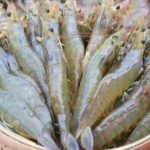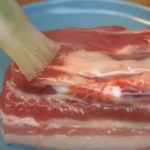Pumpkin is a popular fruit loved by many for its distinctively sweet and fragrant taste. People often buy pumpkins to cook a variety of dishes such as soups, porridge, stews, and even desserts. Each dish brings out a unique and appealing flavor. Pumpkin is also highly nutritious, containing high levels of carotene and vitamin A. Consuming pumpkin is believed to improve children’s eyesight, and it is also thought to help women lose weight and maintain their beauty.

Whether you’re at a local market or a supermarket, you’ll often come across large pumpkins. Usually, these pumpkins are cut into slices or pieces, wrapped in plastic, and sold individually. While these pre-cut pieces may look appealing, they are undoubtedly not as fresh as a whole, untouched pumpkin. However, buying a whole large pumpkin can lead to challenges in storage if not consumed quickly.
Some people opt to cut the pumpkin and wrap the remaining portion in plastic before storing it in the refrigerator. Unfortunately, this method doesn’t prolong the freshness for long, and the pumpkin can quickly become moldy and spoil.

Therefore, a chef’s tip for a simple yet effective preservation method is shared below, which can keep your pumpkin fresh for up to a month.
Here’s a step-by-step guide:
First, buy a large pumpkin and cut a slice to cook immediately. Keep the remaining portion separate for storage. It’s important to note that the part of the pumpkin intended for storage must not be washed or soaked in water. Water exposure can accelerate decay, so keep it dry.
Use a spoon to scoop out the insides of the pumpkin, including the seeds and fibrous strands. This part tends to spoil quickly, so it’s essential to remove it first.
Once the insides are removed, use a clean spoon to apply a small amount of salt to the cut surface of the pumpkin. Avoid sprinkling salt inside the cavity of the pumpkin. Salt acts as a disinfectant, preventing bacterial growth and protecting the cut surface from rapid decay.
Finally, wrap the cut portion of the pumpkin tightly in plastic wrap and store it in the refrigerator’s crisper drawer. When ready to use, simply cut off the salted surface, revealing a fresh, unspoiled piece of pumpkin. This method can keep the pumpkin fresh for up to a month.

Even with this effective preservation method, it’s still best to consume the pumpkin as soon as possible to enjoy its optimal freshness and flavor.
Source: Phụ nữ Việt Nam
The Ultimate Guide to Storing Shrimp: A Simple Trick to Keep Them Fresh and Odor-Free
“Preserving fresh shrimp is an age-old culinary conundrum, but our expert chef has a sweet solution – a simple sugar syrup. In this insightful guide, we reveal the secrets to keeping your shrimp succulent and flavorful for longer. With this knowledge, you’ll never have to hesitate to buy shrimp in bulk again. Indulge in the delights of the sea without worry, and become a master of shrimp storage.”
The Ultimate Guide to Meat Preservation: Keep Your Meat Fresh for Up to Six Months
Introducing the ultimate guide to keeping your pork fresh and flavorful for longer. Forget the fridge for now, there’s a simple extra step you can take to ensure your meat stays in prime condition, just like the day you bought it. With this trick, you’ll be a pork-preserving pro, and your taste buds will thank you!

































